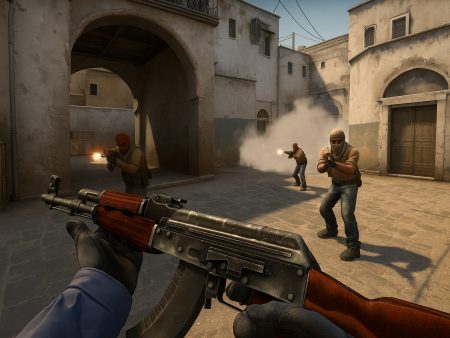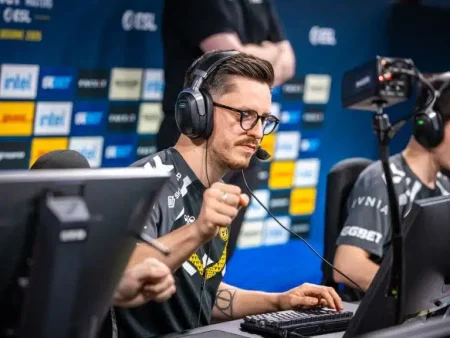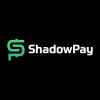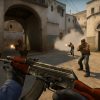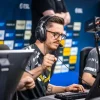Master CS2 utility with this in-depth guide covering smokes, flashes, and molotovs. Learn pro-level tactics, lineups, and strategies to dominate every round.
Why Utility is Crucial in Competitive Play
If you’ve ever wondered what separates average players from high-level competitors in CS2, it’s not just aim—it’s utility usage. Think about it: how many rounds have you lost because the enemy threw a perfect smoke or molly and shut down your push? That’s the power of utility. Smokes, flashes, and molotovs are your best friends—or worst enemies—depending on how well you use them.
In CS2, utility isn’t just about blocking vision or causing damage. It’s about controlling space, manipulating enemy movement, and buying crucial seconds. These tools help you slow down pushes, fake site takes, flush out hiding opponents, or blind enemies for the perfect peek. It’s like chess with explosives—timing, strategy, and precision all come into play.
Another underrated benefit of good utility usage is psychological pressure. A well-thrown smoke or flashbang can make your opponents second-guess themselves, hesitate, or even rotate off a site prematurely. And in CS2, hesitation can cost you the round.
Even if you’re a solo queue warrior or grinding Faceit with friends, mastering utility means taking control of the map. It transforms you from a frag-hunter into a round-winner. And once you get comfortable throwing utility like the pros, you’ll notice a massive difference in your overall impact.
Overview of Smokes, Flashes, and Molotovs
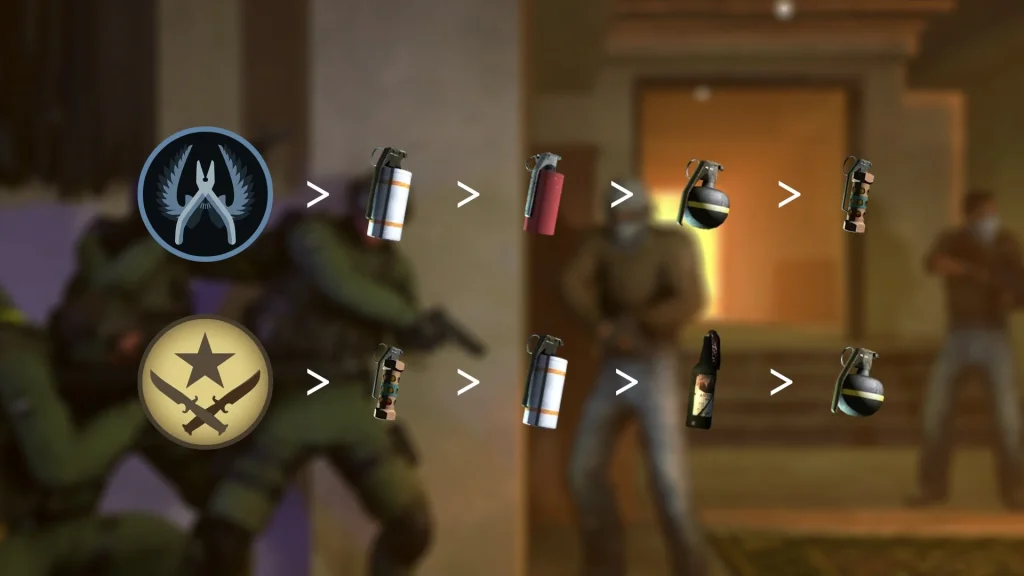
Let’s break down the three major types of utility every CS2 player must understand:
- Smoke Grenades – These provide vision denial, making them perfect for cutting off angles, blocking sniper lines, or enabling site takes. In CS2, smokes behave differently compared to CS:GO, featuring volumetric smoke that reacts to grenades and bullets.
- Flashbangs – These are your engagement starters. A good flash can blind entire teams, opening the door for easy frags. But a poorly timed one? You might end up flashing your own team instead.
- Molotovs/Incendiaries – These are area denial tools. Toss one on Banana on Inferno and you delay a push for seconds. They’re perfect for burning out common spots, forcing movement, and even getting surprise kills.
Mastering these three types of utility doesn’t just make you better—it makes your team deadlier, your rotations smarter, and your clutches more winnable.
Smoke Grenades

Mechanics of Smoke in CS2
CS2’s smoke grenades received a major upgrade compared to their CS:GO counterparts. Valve introduced volumetric smokes, meaning they now fill space realistically. This isn’t just a visual update—it changes the meta.
Here’s how it works:
- Smokes expand over time, creating a 3D cloud that reacts to the environment. Throw one into a tight corner? It will fill that corner naturally rather than forming a static ball.
- Explosives like grenades or molotovs can push the smoke away. This adds a new tactical layer—imagine HE-nading a smoke to get a temporary line of sight.
- Bullet interaction is real. Shooting through the smoke can disperse it slightly, revealing silhouettes or even giving you a peek shot.
The result is a far more dynamic system. You can’t just assume a smoke blocks vision entirely anymore. Players are using nades and spam to “peek” through smokes, making timing and positioning even more critical.
And with the CS2 engine, smoke visibility differs from player to player depending on positioning. What looks like a fully blocked angle for you might actually be a gap for the enemy. Scary, right?
Strategic Uses of Smokes
Smokes aren’t just for blocking vision. When used smartly, they become tools of deception, delay, and control.
Here are some practical uses:
- Site Entry Smokes: On maps like Mirage or Dust2, throwing standard smokes (like CT or Jungle) allows you to enter sites safely.
- One-Way Smokes: When placed cleverly, smokes can create a visual gap for you while remaining invisible to enemies.
- Lurk Smokes: Drop a smoke to give the impression you’re pushing, then wait and catch rotating enemies off guard.
- Retake Smokes: Use them to cut off choke points or isolate angles while defusing.
Want to take A site on Mirage? Smoke CT, Jungle, and Stairs. Want to defend B site on Inferno solo? Smoke mid and delay. It’s that simple, but the timing must be perfect.
Using smokes effectively is what separates a clutch player from a clueless one.
Best Smoke Spots on Popular Maps
Let’s get specific. If you want to be effective, you need to know your smoke lineups. Here are some go-to smokes for the most played maps:
Mirage
- CT Smoke: From T-spawn, aim toward the center and block CT view for an A site push.
- Jungle Smoke: Essential for mid-to-A split plays.
- Window Smoke: Mid control starts here. Master this from T-spawn or underpass.
Inferno
- Top Banana Smoke: Delays CT aggression or T push.
- CT Smoke (B Site): Vital for late-game executes.
- Library/Arch Smoke: Covers rotation points during A site hits.
Dust2
- Cross Smoke (A Long): Combine with a flash to cross safely.
- Mid to B Smoke: Enables sneaky B plays without alerting too much attention.
- Xbox Smoke: Key for mid control and catwalk pushes.
If you’re serious about improvement, set aside time to practice these smokes in offline servers or use custom workshop maps. Muscle memory turns good players into legends.
Utility Economy Management
Cost vs. Value of Each Grenade
Every grenade in CS2 comes with a price tag—and in tight economy rounds, those dollars matter. Understanding the cost-to-impact ratio of each piece of utility is key to smart buying.
Here’s a quick breakdown of the costs:
| Grenade | Cost |
|---|---|
| Smoke Grenade | $300 |
| Flashbang | $200 |
| HE Grenade | $300 |
| Molotov (T-side) | $400 |
| Incendiary (CT) | $600 |
| Decoy Grenade | $50 |
So what’s the most bang for your buck?
- Flashbangs offer the highest potential return. For just $200, you can blind multiple opponents and swing for easy kills. That’s a possible $5,000+ kill potential from a $200 investment.
- Smokes are the most strategic grenade. For only $300, you can deny vision, fake pushes, or force repositioning.
- Molotovs and Incendiaries are more expensive, but when used right, they can delay pushes, flush out players, or win post-plant situations.
- Decoys? Sometimes useful in fakes or noise baiting, but generally not a priority unless you’re executing a very specific strat.
The key is to align your utility buy with your team’s goal for the round. Executing a full A push? Everyone needs smokes and flashes. Playing for picks? Maybe just one molly and some pop flashes will do.
When to Buy What
In low-buy or eco rounds, don’t waste money on full sets unless it’s part of a coordinated plan. Here’s a basic guide to help decide:
- Full Buy Rounds: Always buy at least 2–3 grenades. Flash + Smoke is a minimal setup. Add molotov or HE if budget allows.
- Force Buys: Prioritize flashbangs and smokes. Molotovs might be too costly unless you’re anchoring.
- Eco Rounds: One or two smokes can be used for fakes or post-plant chances. Don’t over-invest.
- Post-Plant Rounds: Save utility during bomb plant for retake denial or defuse control.
Utility should be treated like a weapon. Don’t just spend it because you have it. Plan each round’s utility use based on positioning, timing, and enemy tendencies.
Practicing Utility Lineups
Training Maps and Custom Servers
You’ve read all about the importance of utility. But reading isn’t enough. You need practice, and CS2 offers several ways to perfect your nades.
Start by downloading workshop maps designed for practicing utility:
- Yprac Practice Maps – These are legendary for a reason. You can set up smokes, flashes, molotovs, and even simulate bot peeks.
- Crashz’s Crosshair and Nade Training – Great for beginners who want to understand angles and grenades better.
- Recoil Master + Nade Practice – Includes scripting that shows grenade trajectories, hit timing, and helps you refine throw strength.
What makes these maps great is repetition. You can throw the same smoke 20 times in a row until it lands perfectly every time. This builds the muscle memory that translates into ranked matches.
Also, using the in-game grenade preview command helps visualize how grenades bounce and explode:
sv_grenade_trajectory 1
sv_cheats 1
sv_infinite_ammo 1
(These work in private servers only)
Creating Your Own Lineups
Creating custom lineups is where creativity and map knowledge come together.
Let’s say you found a new angle while exploring Ancient, and realized you can throw a CT smoke from mid stairs. That’s your lineup now.
How to make your own lineup:
- Find a consistent reference point (like a dot on the wall or a plank).
- Stand in the exact spot every time.
- Aim at a precise pixel or edge.
- Note the type of throw – jump throw, running throw, or normal.
- Record it in your notes or take screenshots.
These self-made lineups become your signature tactics. Opponents won’t know how you got that perfect molotov on site without exposing yourself. That unpredictability gives you the edge.
The more custom lineups you build, the more map control you gain. And once you share them with your squad? Now you’re shaping the meta.
Common Mistakes with Utility
Wasted Utility and Timing Issues
Ever seen someone throw a smoke and no one pushes behind it? Or two teammates throw flashes at the same time, blinding no one? That’s wasted utility, and it’s a huge problem.
Common mistakes:
- Throwing utility too early: This gives opponents time to wait it out or rotate.
- Double throwing: Two players using the same grenade (like double molly on Banana) wastes resources.
- Poor timing: Flash goes off before your team peeks, or a smoke lands after the push starts.
- No follow-up: Utility is thrown, but no one uses the advantage.
Timing is everything. A perfect smoke is useless if your team is still 10 seconds away from the site. Similarly, a flashbang does nothing if you peek 2 seconds after it pops.
Communicate your plan. One player throws, the other pushes. If you’re solo, at least make sure your flash or molly is followed by movement. Utility is meant to create opportunities—not decorate the map.
Over-Reliance and Predictability
It’s tempting to use utility in the same way every round. But smart opponents learn patterns fast.
Using the same smokes or molotovs over and over makes you predictable. Eventually, enemies will pre-aim your smoke edge or push your molly knowing you’re faking.
Here’s how to stay unpredictable:
- Change timings: Delay your utility or throw early to confuse.
- Vary lineups: Use alternative throws to land the same smokes from different positions.
- Throw fakes: Smoke CT like you’re hitting B, but rotate A silently.
- Save utility: Sometimes, holding a molotov for the post-plant is more valuable than an early burn.
Being unpredictable doesn’t mean random. It means intentional variation that keeps enemies guessing.
Advanced Utility Techniques
Fake Executions
This is where utility gets fun. Imagine tossing full A site smokes on Mirage—CT, Jungle, Stairs—and the defenders rotate instantly… only for you to silently walk into B.
Fake executions rely on utility patterns your enemies recognize. When they see certain smokes, they make assumptions—and that’s where you strike.
How to run a fake exec:
- Throw 2–3 utility pieces associated with a real site take.
- Create noise (running, shooting) to sell it.
- Rotate fast to the real site with the rest of the team.
- Plant before they realize they were duped.
You can even leave one player behind to keep the illusion alive—a “lurker” who continues throwing nades or even trades 1-for-1.
Fake executes are high-risk, high-reward. If the enemy doesn’t bite, you’re low on utility. But if they over-rotate? Free site.
Baiting and Utility Conditioning
Utility conditioning is when you teach the enemy to expect something based on your previous behavior.
For example:
- You throw a molotov into dark corner on B site 3 rounds in a row. They stop playing there. In round 4, you don’t throw it—and catch the rotate instead.
- You always smoke Top Mid. One round, you don’t—opponents peek, and you’re waiting with the AWP.
Baiting utility is another clever trick. Stand near Banana, show presence, let them molly and smoke—then fall back. You just burned $800+ worth of their utility for free.
These mind games can break your opponent’s confidence and make them second-guess every step.
Utility in Pro Play: Analysis
Iconic Utility Plays in CS2
Want to really grasp how game-changing utility can be? Just look at the pros. Some of the most iconic rounds in CS history have come down to a single smoke or flashbang used at the perfect time.
Let’s explore a few examples:
- One-Way Smokes by s1mple on Mirage: He uses precise one-way lineups to peek under smokes and secure free kills without being seen.
- Molly + HE Combos by NiKo on Inferno: A pre-placed molotov followed by a nade results in instant frags on rushing Ts in Banana.
- The Famous “Fake Smoke Defuse”: Multiple times in pro matches, we’ve seen players smoke the bomb, start defusing, and bait peeks, only to get multi-kills in the smoke.
CS2’s updated utility mechanics have only amplified the creativity in these plays. Pro teams now combine volumetric smokes with utility disruption—like using HE grenades to temporarily clear vision inside the smoke.
Watch tournament demos and you’ll see how top teams layer utility, use it late into the round, and coordinate perfectly. It’s an art form—and one you can learn from.
What You Can Learn from the Pros
Watching pros isn’t just for entertainment—it’s a masterclass in how to use utility to win rounds. Here’s what you should focus on when studying demos:
- Timing: Notice how they delay certain smokes until 30 seconds left? That’s intentional. It denies information and creates pressure.
- Utility Stacking: Teams don’t just throw one flash—they layer them. One blinds deep, another closer. One molly clears back site, one burns default.
- Information Denial: Many teams smoke off key enemy positions to force rotates or bait pushes.
- Communication: In interviews and team comms, it’s clear—pros talk constantly about what they’re throwing and when.
Take notes. Replicate the setups in practice servers. Once you internalize pro-level utility usage, your decision-making becomes second nature.
Conclusion
CS2 isn’t just about sharp aim and fast reflexes—it’s a tactical battle, and utility is your arsenal of control. Mastering smokes, flashes, and molotovs turns you from a decent player into a team-carrying beast.
Let’s recap what we’ve covered:
- Smokes deny vision, shape engagements, and create opportunities.
- Flashes open up fights, blind angles, and support peeks.
- Molotovs control space, delay enemy movement, and clutch rounds.
- Combining utility with timing and teamwork creates unbreakable site executions and solid defensive holds.
- Practicing lineups, managing your grenade economy, and avoiding predictability are critical for long-term improvement.
But most importantly? Practice. Learn. Adjust.
Spend time in custom servers. Watch pro demos. Develop your own lineups. Before long, you won’t just be playing CS2—you’ll be controlling the battlefield.
FAQs
How do I practice smokes and flashes in CS2?
Use custom workshop maps like Yprac or Crashz’s training maps. Alternatively, create your own local game and enable grenade trajectory with sv_grenade_trajectory 1. This lets you perfect throws, angles, and timings.
What’s the difference between Molotov and Incendiary?
Molotovs (T-side) and Incendiaries (CT-side) serve the same purpose—area denial. The main differences are cost (Molotov is $400, Incendiary is $600) and sometimes slight difference in throw timing or spread pattern.
How do pros never flash themselves?
Pros communicate flash timings and perfect the art of throwing behind walls or around corners. They also use pop flashes that detonate right after bouncing—too fast for enemies to turn, but timed perfectly for teammates.
Are there one-way smokes in CS2?
Yes, though harder due to volumetric smoke changes. You can still create one-ways by abusing height, corners, or throwing nades to interact with smoke. However, timing and lineup consistency are key.
What is the best grenade for retaking a site?
Flashbangs are the MVP for retakes. A well-placed flash can blind multiple enemies. Molotovs are also strong for clearing angles. Smokes can isolate areas or defuse the bomb. Combine them for the best effect.
